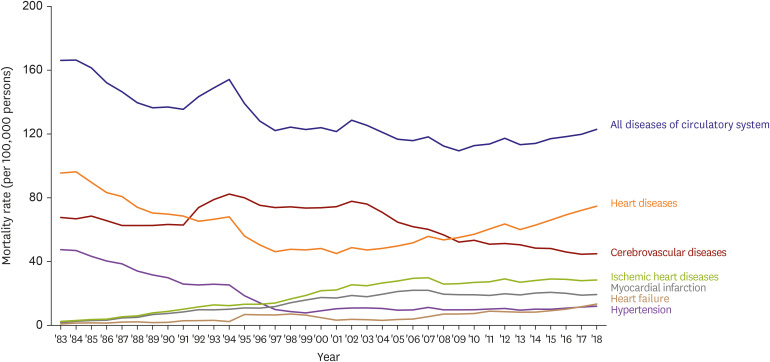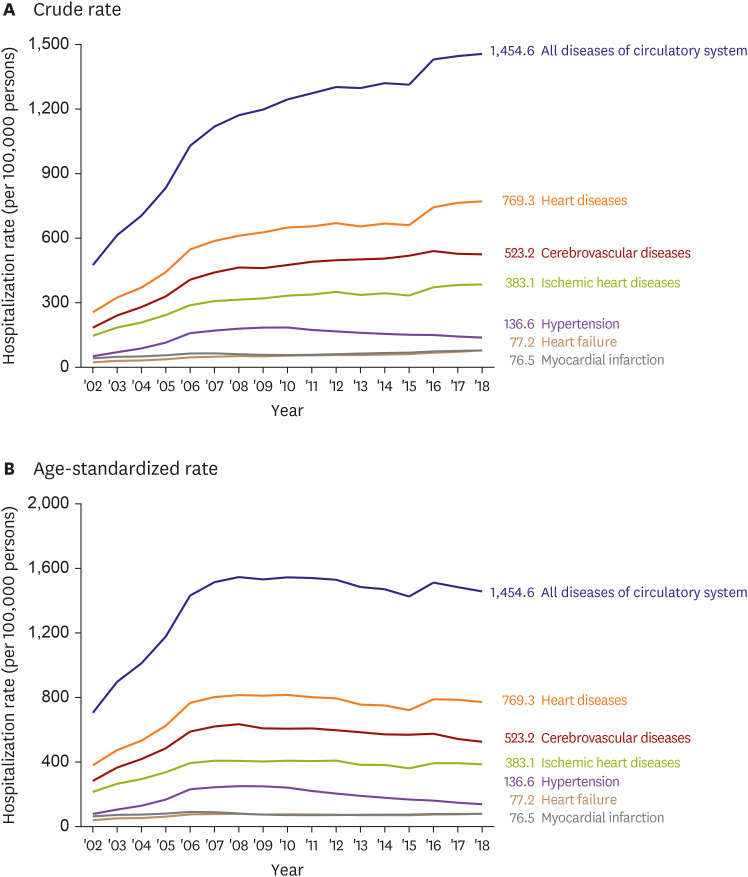Korea Heart Disease Fact Sheet 2020: Analysis of Nationwide Data
- Affiliations
-
- 1Department of Preventive Medicine, Yonsei University College of Medicine, Seoul, Korea
- 2Department of Internal Medicine, Yonsei University College of Medicine, Seoul, Korea
- 3Division of Cardiology, Department of Internal Medicine, Heart Center, Konyang University Hospital, Daejeon, Korea
- 4Department of Cardiovascular Medicine, Gachon University Gil Medical Center, Incheon, Korea
- 5Gachon Cardiovascular Research Institute, Gachon University, Incheon, Korea
- KMID: 2516210
- DOI: http://doi.org/10.4070/kcj.2021.0097
Abstract
- Background and Objectives
Cardiovascular disease (CVD) is the leading cause of death and disability worldwide. To provide an overview of the temporal trends in the burden of CVD, the Korean Society of Cardiology has published the Korea Heart Disease Fact Sheet in 2020.
Methods
We analyzed anonymized data of the Causes of Death Statistics, National Health Insurance Claims Database, and Korea National Health and Nutrition Examination Survey to assess mortality, hospitalizations, and risk factors for CVD.
Results
The CVD mortality decreased until 2010, then steadily increased up to 123 per 100,000 persons in 2018. Since 2002, the number and rate of CVD hospitalization have continued to grow. In 2018, approximately 12.1 million Korean adults had hypertension, 4.3 million had diabetes, 8.7 million had hypercholesterolemia, 14.9 million had obesity, and 8.8 million were currently smoking. The number of risk factors increased markedly with older age; 58.4% of adults age ≥70 years had ≥2 risk factors.
Conclusions
CVD mortality and hospitalization have gradually increased in the last decade, and a substantially high proportion of adults were carrying more than 1 cardiovascular risk factor in 2018. With the rapid population aging, a continued increase in CVD appears inevitable in Korea. Concerted and sustained approaches are essential to achieve early prevention and reduce the burden of CVD.
Figure
Cited by 10 articles
-
Modifiable Risk Factors for Cardiovascular Disease in Korea and Japan
Ahmed Arafa, Hyeok-Hee Lee, Ehab S. Eshak, Kokoro Shirai, Keyang Liu, Jiaqi Li, Naharin Sultana Anni, Sun Young Shim, Hyeon Chang Kim, Hiroyasu Iso
Korean Circ J. 2021;51(8):643-655. doi: 10.4070/kcj.2021.0121.Venous Thromboembolism in Heart Failure Patients: Building Evidence towards Better Care and the Need for Precision
Seung-Pyo Lee
Korean Circ J. 2021;51(9):781-783. doi: 10.4070/kcj.2021.0244.Sex- and Age-Specific Trends in Cardiovascular Health in Korea, 2007–2018
So Mi Jemma Cho, Hokyou Lee, Hyeon Chang Kim
Korean Circ J. 2021;51(11):922-935. doi: 10.4070/kcj.2021.0211.Sex-Specific Trends in the Prevalence of Hypertension and the Number of People With Hypertension: Analysis of the Korea National Health and Nutrition Examination Survey (KNHANES) 1998–2018
Eunsun Seo, Sunjae Jung, Hokyou Lee, Hyeon Chang Kim
Korean Circ J. 2022;52(5):382-392. doi: 10.4070/kcj.2021.0347.Hypertension in Older Women: The Biggest Challenge for Cardiovascular Health in an Aged Society
Kwang-il Kim
Korean Circ J. 2022;52(5):393-394. doi: 10.4070/kcj.2022.0036.What Regional Disparity Trends of Cardiovascular Mortality Have Changed in 2019 Compared to the 1980s?
Sung Il Im
Korean Circ J. 2022;52(11):844-846. doi: 10.4070/kcj.2022.0276.Smoking and Cardiovascular Disease in Young Adults: Can We Restore the Risk by Cessation Alone?
Hyeok-Hee Lee, Hokyou Lee
Korean Circ J. 2022;53(1):31-33. doi: 10.4070/kcj.2022.0315.Korean Society of Heart Failure Guidelines for the Management of Heart Failure: Definition and Diagnosis
Jae Yeong Cho, Dong-Hyuk Cho, Jong-Chan Youn, Darae Kim, Sang Min Park, Mi-Hyang Jung, Junho Hyun, Jimi Choi, Hyun-Jai Cho, Seong-Mi Park, Jin-Oh Choi, Wook-Jin Chung, Byung-Su Yoo, Seok-Min Kang,
Korean Circ J. 2023;53(4):195-216. doi: 10.4070/kcj.2023.0046.Sex Differences in Coronary Artery Disease: Insights From the KoRean wOmen’S chest pain rEgistry (KoROSE)
Hack-Lyoung Kim, Myung-A Kim
Korean Circ J. 2023;53(10):655-676. doi: 10.4070/kcj.2023.0205.Long-Term Cumulative Exposure to High γ-Glutamyl Transferase Levels and the Risk of Cardiovascular Disease: A Nationwide Population-Based Cohort Study
Han-Sang Baek, Bongseong Kim, Seung-Hwan Lee, Dong-Jun Lim, Hyuk-Sang Kwon, Sang-Ah Chang, Kyungdo Han, Jae-Seung Yun
Endocrinol Metab. 2023;38(6):770-781. doi: 10.3803/EnM.2023.1726.
Reference
-
1. GBD 2017 Causes of Death Collaborators. Global, regional, and national age-sex-specific mortality for 282 causes of death in 195 countries and territories, 1980-2017: a systematic analysis for the Global Burden of Disease Study 2017. Lancet. 2018; 392:1736–1788. PMID: 30496103.2. World Health Organization. Cardiovascular diseases fact sheet [Internet]. Geneva: WHO;2017. cited 2021 January 7. Available from: https://www.who.int/en/news-room/fact-sheets/detail/cardiovascular-diseases-(cvds).3. Statistics Korea. Causes of Death Statistics in 2019. Daejeon: Statistics Korea;2020.4. Mensah GA, Wei GS, Sorlie PD, et al. Decline in cardiovascular mortality: possible causes and implications. Circ Res. 2017; 120:366–380. PMID: 28104770.5. Lee SW, Kim HC, Lee HS, Suh I. Thirty-year trends in mortality from cardiovascular diseases in Korea. Korean Circ J. 2015; 45:202–209. PMID: 26023308.
Article6. Lee SW, Kim HC, Lee HS, Suh I. Thirty-year trends in mortality from cerebrovascular diseases in Korea. Korean Circ J. 2016; 46:507–514. PMID: 27482259.
Article7. Sung KC, Ryu S, Cheong ES, et al. All-cause and cardiovascular mortality among Koreans: effects of obesity and metabolic health. Am J Prev Med. 2015; 49:62–71. PMID: 26094228.8. Hong JS, Kang HC, Lee SH, Kim J. Long-term trend in the incidence of acute myocardial infarction in Korea: 1997-2007. Korean Circ J. 2009; 39:467–476. PMID: 19997542.
Article9. Kim RB, Kim HS, Kang DR, et al. The trend in incidence and case-fatality of hospitalized acute myocardial infarction patients in Korea, 2007 to 2016. J Korean Med Sci. 2019; 34:e322. PMID: 31880418.10. Seo SR, Kim SY, Lee SY, et al. The incidence of stroke by socioeconomic status, age, sex, and stroke subtype: a nationwide study in Korea. J Prev Med Public Health. 2014; 47:104–112. PMID: 24744827.
Article11. Kim JY, Kang K, Kang J, et al. Executive summary of stroke statistics in Korea 2018: a report from the epidemiology research council of the Korean Stroke Society. J Stroke. 2019; 21:42–59. PMID: 30558400.12. Lee JH, Lim NK, Cho MC, Park HY. Epidemiology of heart failure in Korea: present and future. Korean Circ J. 2016; 46:658–664. PMID: 27721857.
Article13. Youn JC, Han S, Ryu KH. Temporal trends of hospitalized patients with heart failure in Korea. Korean Circ J. 2017; 47:16–24. PMID: 28154584.
Article14. Kim HC, Cho SMJ, Lee H, et al. Korea hypertension fact sheet 2020: analysis of nationwide population-based data. Clin Hypertens. 2021; 27:8. PMID: 33715619.
Article15. Kim BY, Won JC, Lee JH, et al. Diabetes fact sheets in Korea, 2018: an appraisal of current status. Diabetes Metab J. 2019; 43:487–494. PMID: 31339012.16. Park JY, Hong SJ, Joo HJ, et al. Dyslipidemia fact sheets in Korea, 2020 [Internet]. Seoul: The Korean Society of Lipid and Atherosclerosis;2020. cited 2021 March 9. Available from: https://www.lipid.or.kr/bbs/skin/default/download.php?code=fact_sheet&number=1392.17. Nam GE, Kim YH, Han K, et al. Obesity fact sheet in Korea, 2018: data focusing on waist circumference and obesity-related comorbidities. J Obes Metab Syndr. 2019; 28:236–245. PMID: 31909366.18. Huh JH, Kang DR, Jang JY, et al. Metabolic syndrome epidemic among Korean adults: Korean survey of cardiometabolic syndrome (2018). Atherosclerosis. 2018; 277:47–52. PMID: 30172084.
Article19. Seong SC, Kim YY, Khang YH, et al. Data resource profile: The National Health Information Database of the National Health Insurance Service in South Korea. Int J Epidemiol. 2017; 46:799–800. PMID: 27794523.
- Full Text Links
- Actions
-
Cited
- CITED
-
- Close
- Share
- Similar articles
-
- Prevalence and Current Management of Cardiovascular Risk Factors in Korean Adults Based on Fact Sheets
- Dementia Epidemiology Fact Sheet 2022
- Correction to: Korea hypertension fact sheet 2020: analysis of nationwide population-based data
- Korea hypertension fact sheet 2022: analysis of nationwide population-based data with a special focus on hypertension in the elderly
- Obesity Fact Sheet in Korea, 2020: Prevalence of Obesity by Obesity Class from 2009 to 2018






